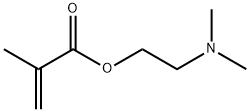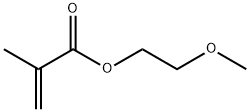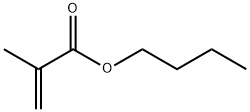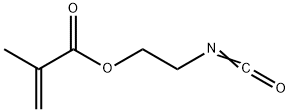2-(Dimethylamino)ethyl methacrylate
Synonym(s):(2-Dimethylaminoethyl) methacrylate;2-Propenoic acid-2-methyl-(2-dimethylamino)ethylester;Methacrylic acid 2-(dimethylamino)ethyl ester
- CAS NO.:2867-47-2
- Empirical Formula: C8H15NO2
- Molecular Weight: 157.21
- MDL number: MFCD00008589
- EINECS: 220-688-8
- SAFETY DATA SHEET (SDS)
- Update Date: 2024-12-18 14:07:02

What is 2-(Dimethylamino)ethyl methacrylate?
Chemical properties
colourless liquid
The Uses of 2-(Dimethylamino)ethyl methacrylate
2-(Dimethylamino)ethyl methacrylate is used in the synthesis of poly ((2-(Dimethylamino)ethyl methacrylate), block copolymers of 2-(Dimethylamino)ethyl methacrylate and n-butyl methacrylate and amphiphilic AB block copolymers of 2-(Dimethylamino)ethyl methacrylate. It is also used in the preparation of polymer.
The Uses of 2-(Dimethylamino)ethyl methacrylate
N,N-Dimethylaminoethyl-methacrylate is an amine activator in visible-light-cured dental-acrylic composite materials.
The Uses of 2-(Dimethylamino)ethyl methacrylate
2-(Dimethylamino)ethyl methacrylate may be used in:
- the synthesis of poly ((2-(Dimethylamino)ethyl methacrylate)
- block copolymers of 2-(Dimethylamino)ethyl methacrylate and n-butyl methacrylate
- amphiphilic AB block copolymers of 2-(Dimethylamino)ethyl methacrylate
What are the applications of Application
2-(Dimethylamino)ethyl methacrylate is used in the synthesis of poly ((2-(Dimethylamino)ethyl methacrylate)
General Description
A clear colorless liquid. Less dense than water and insoluble in water. Vapors heavier than air and corrosive to eyes and mucous membranes. May polymerize exothermically if heated or contaminated. If polymerization takes place inside a closed container, the container may rupture violently. Produces toxic oxides of nitrogen during combustion. Toxic by skin absorption, ingestion and inhalation. Used to make plastics and in textiles.
Air & Water Reactions
Insoluble in water.
Reactivity Profile
2-(Dimethylamino)ethyl methacrylate is both an amine and an ester. Amines are chemical bases. They neutralize acids to form salts plus water. These acid-base reactions are exothermic. The amount of heat that is evolved per mole of amine in a neutralization is largely independent of the strength of the amine as a base. Amines may be incompatible with isocyanates, halogenated organics, peroxides, phenols (acidic), epoxides, anhydrides, and acid halides. Flammable gaseous hydrogen is generated by amines in combination with strong reducing agents, such as hydrides. Esters react with acids to liberate heat along with alcohols and acids. Strong oxidizing acids may cause a vigorous reaction that is sufficiently exothermic to ignite the reaction products. Heat is also generated by the interaction of esters with caustic solutions. Flammable hydrogen is generated by mixing esters with alkali metals and hydrides.
Health Hazard
TOXIC; inhalation, ingestion or skin contact with material may cause severe injury or death. Contact with molten substance may cause severe burns to skin and eyes. Avoid any skin contact. Effects of contact or inhalation may be delayed. Fire may produce irritating, corrosive and/or toxic gases. Runoff from fire control or dilution water may be corrosive and/or toxic and cause pollution.
Fire Hazard
Combustible material: may burn but does not ignite readily. When heated, vapors may form explosive mixtures with air: indoors, outdoors and sewers explosion hazards. May polymerize explosively when heated or involved in a fire. Contact with metals may evolve flammable hydrogen gas. Containers may explode when heated. Runoff may pollute waterways. Substance may be transported in a molten form.
Safety Profile
Poison by intraperitoneal route. Moderately toxic by ingestion and inhalation. A skin eye, and mucous membrane irritant. A powerful lachrymator. Flammable when exposed to sparks, heat, open flame, or oxidizers. To fight fire, use alcohol foam, dry chemical, spray. When heated to decomposition it emits toxic fumes of NOx. See also ESTERS.
Properties of 2-(Dimethylamino)ethyl methacrylate
| Melting point: | -50 °C |
| Boiling point: | 182-192 °C(lit.) |
| Density | 0.933 g/mL at 25 °C(lit.) |
| vapor density | 5.4 (vs air) |
| vapor pressure | <1 mm Hg ( 25 °C) |
| refractive index | n |
| Flash point: | 149 °F |
| storage temp. | 2-8°C |
| solubility | 500g/l soluble |
| form | Liquid |
| pka | 8.18±0.28(Predicted) |
| color | Clear colorless Liquid |
| explosive limit | 1.20%(V) |
| Water Solubility | Less dense than water and insoluble in water. |
| BRN | 1757048 |
| Stability: | Stable. Incompatible with strong acids, strong bases, strong oxidizing or reducing agents. May decompose on exposure to air and moisture. May undergo autopolymerization. Light sensitive. |
| CAS DataBase Reference | 2867-47-2(CAS DataBase Reference) |
| NIST Chemistry Reference | Dimethylaminoethyl methacrylate(2867-47-2) |
| EPA Substance Registry System | 2-(Dimethylamino)ethyl methacrylate (2867-47-2) |
Safety information for 2-(Dimethylamino)ethyl methacrylate
| Signal word | Danger |
| Pictogram(s) |
 Corrosion Corrosives GHS05  Exclamation Mark Irritant GHS07 |
| GHS Hazard Statements |
H314:Skin corrosion/irritation H317:Sensitisation, Skin |
| Precautionary Statement Codes |
P261:Avoid breathing dust/fume/gas/mist/vapours/spray. P270:Do not eat, drink or smoke when using this product. P280:Wear protective gloves/protective clothing/eye protection/face protection. P301+P312:IF SWALLOWED: call a POISON CENTER or doctor/physician IF you feel unwell. P303+P361+P353:IF ON SKIN (or hair): Remove/Take off Immediately all contaminated clothing. Rinse SKIN with water/shower. P305+P351+P338:IF IN EYES: Rinse cautiously with water for several minutes. Remove contact lenses, if present and easy to do. Continuerinsing. |
Computed Descriptors for 2-(Dimethylamino)ethyl methacrylate
| InChIKey | JKNCOURZONDCGV-UHFFFAOYSA-N |
New Products
(S)-3-Aminobutanenitrile hydrochloride 4-Methylphenylacetic acid N-Boc-D-alaninol N-BOC-D/L-ALANINOL Tert-butyl bis(2-chloroethyl)carbamate 3-Morpholino-1-(4-nitrophenyl)-5,6-dihydropyridin- 2(1H)-one Furan-2,5-Dicarboxylic Acid Tropic acid 1-Bromo-3,5-Di-Tert-Butylbenzene S-2-CHLORO PROPIONIC ACID ETHYL ISOCYANOACETATE 2-Bromo-1,3-Bis(Dimethylamino)Trimethinium Hexafluorophosphate 4-IODO BENZOIC ACID 3-NITRO-2-METHYL ANILINE 1-(2,4-DICHLOROPHENYL) ETHANAMINE (2-Hydroxyphenyl)acetonitrile 4-Bromopyrazole 2-(Cyanocyclohexyl)acetic acid 4-methoxy-3,5-dinitropyridine 1-(4-(aminomethyl)benzyl)urea hydrochloride 2-aminopropyl benzoate hydrochloride diethyl 2-(2-((tertbutoxycarbonyl)amino) ethyl)malonate tert-butyl 4- (ureidomethyl)benzylcarbamate Ethyl-2-chloro((4-methoxyphenyl)hydrazono)acetateRelated products of tetrahydrofuran








You may like
-
 2-(Dimethylamino)ethyl Methacrylate (stabilized with MEHQ) CAS 2867-47-2View Details
2-(Dimethylamino)ethyl Methacrylate (stabilized with MEHQ) CAS 2867-47-2View Details
2867-47-2 -
 2-Dimethyl Amino Ethyl Methacrylate CASView Details
2-Dimethyl Amino Ethyl Methacrylate CASView Details -
 2-(Dimethylamino)ethyl methacrylate, stabilized with ≈0.2% 4-methoxyphenol CAS 2867-47-2View Details
2-(Dimethylamino)ethyl methacrylate, stabilized with ≈0.2% 4-methoxyphenol CAS 2867-47-2View Details
2867-47-2 -
 2-(Dimethylamino)ethyl methacrylate, 98% CAS 2867-47-2View Details
2-(Dimethylamino)ethyl methacrylate, 98% CAS 2867-47-2View Details
2867-47-2 -
 2-(Dimethylamino)ethyl methacrylate CAS 2867-47-2View Details
2-(Dimethylamino)ethyl methacrylate CAS 2867-47-2View Details
2867-47-2 -
 (2-Dimethylaminoethyl) methacrylate CAS 2867-47-2View Details
(2-Dimethylaminoethyl) methacrylate CAS 2867-47-2View Details
2867-47-2 -
 14714-50-2 (2-Hydroxyphenyl)acetonitrile 98+View Details
14714-50-2 (2-Hydroxyphenyl)acetonitrile 98+View Details
14714-50-2 -
 118753-70-1 98+View Details
118753-70-1 98+View Details
118753-70-1